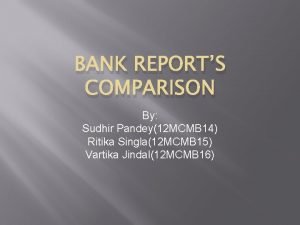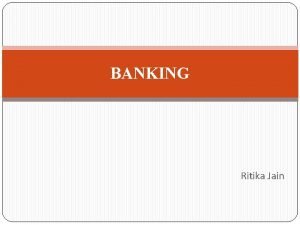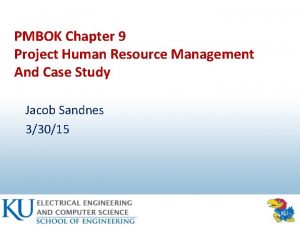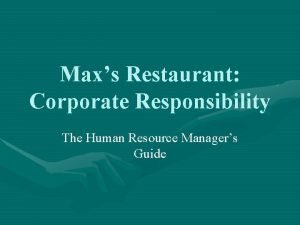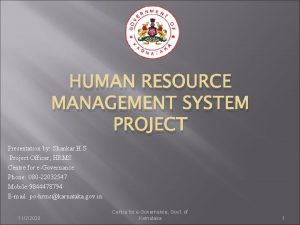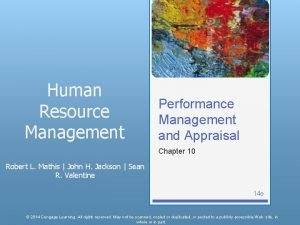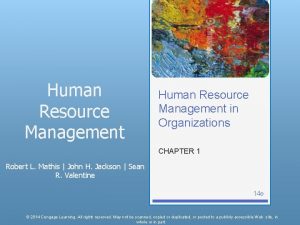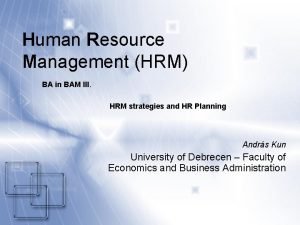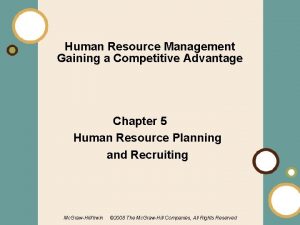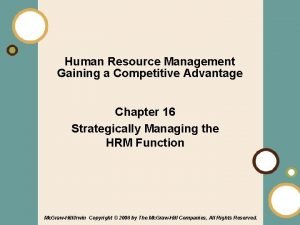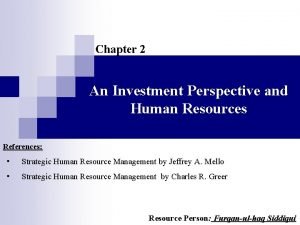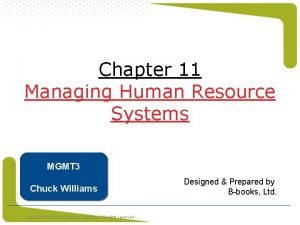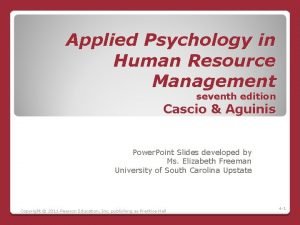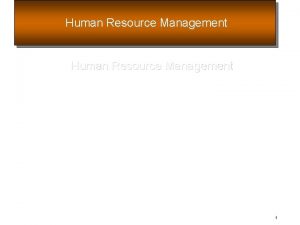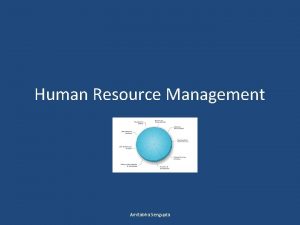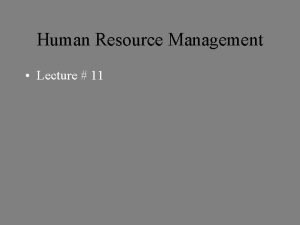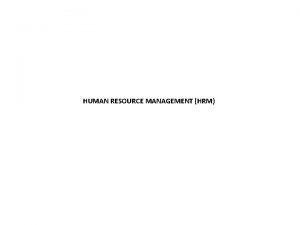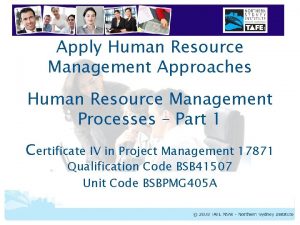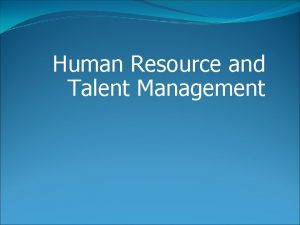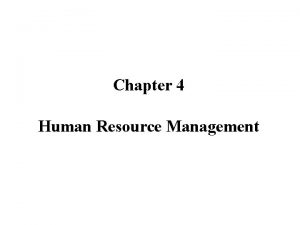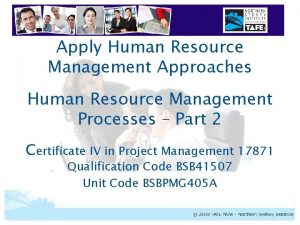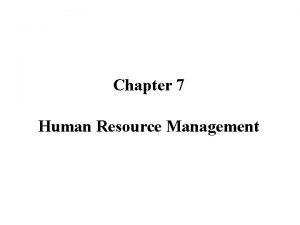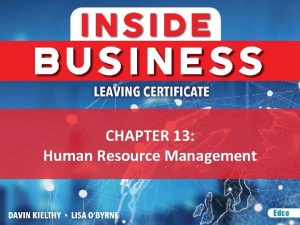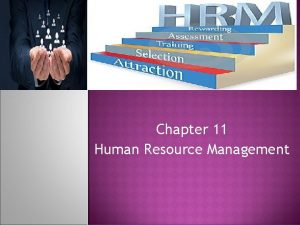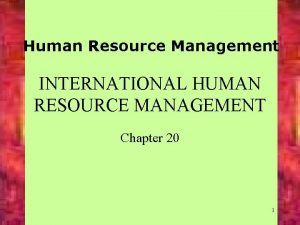Human Resource Management RITIKA SHARMA 1 What is































- Slides: 31

Human Resource Management RITIKA SHARMA 1

What is Human Resource Management � HRM is a process for staffing the organization and sustaining high employee performance. � HRM can be defined as all the practices, systems and procedures implemented to attract, acquire, develop and manage human resources to achieve the goals of an organization. � Simply it is managing the employment relationship � While Miller (1987) suggests that HRM relates to: ". . . . those decisions and actions which concern the management of employees at all levels in the business and which are related to the implementation of strategies directed towards creating and sustaining competitive advantage" Ritika Sharma 2

Importance of Human Resource Management � Staff is the most important resource of an organization. � Human resource is the key ingredient to success. � “Human resource” creates organizational accomplishments and innovations. Ritika Sharma 3

Functions of Human Resource Management The Human Resources Management (HRM) function includes a variety of activities, and key among them is deciding the staffing needs of an organization and whether to use independent contractors or hire employees to fill these needs, recruiting and training the best employees, ensuring they are high performers, dealing with performance issues, and ensuring your personnel and management practices conform to various regulations. Activities also include managing your approach to employee benefits and compensation, employee records and personnel policies. Ritika Sharma 4

1 HR Planning 3 2 Recruitment Selection HRM process 9 Employee relation Ritika Sharma 8 Compensati on 7 Performance Appraisal 4 Orientation 5 Placement 6 Training and Developme nt 5

1. HR Planning � The process of determining future human resource needs relative to an organization's strategic plan and taking the actions necessary to meet those in a timely manner Ritika Sharma 6

1 HR PLANNING Definition of 'Human Resource Planning - HRP‘ The ongoing process of systematic planning to achieve optimum use of an organization's most valuable asset – its human resources. The objective of human resource (HR) planning is to ensure the best fit between employees and jobs, while avoiding manpower shortages or surpluses. The three key elements of the HR planning process are forecasting labor demand, analyzing present labor supply, and balancing projected labor demand supply. Ritika Sharma 7

2 Recruitment � The process of identifying and hiring the bestqualified candidate (from within or outside of an organization) for a job vacancy, in a most timely and cost effective manner. Ritika Sharma 8

Job Analysis (What is the Job) 2 Recruitment Job Analysis JOB DESCRIPTION (written Statement JOB SPECIFICATION (Min. Qualification & skills required) Attracting and Managing Applications Selecting Candidates- Shortlisting and assessment Making the appointment Ritika Sharma Joining the organisation/Induction 9

2 Recruitment Job Analysis Steps in Job Analysis: 1. Job Description A written statement of what a job holder does, how its done and why it is done. 2. Job specification A statement of the minimum qualifications that a person must possess to perform a given job successfully. Ritika Sharma 10

2 Recruitment Job Analysis INTERVIEW QUESTIONNAIRE Methods of Collecting Information OBSERVATION Ritika Sharma PREVIOUS STUDIES or WORK DIARIES 11

2 Recruitment Writing Job Description (Format) Title of the Job Summary: …………………………………………………………………… Responsibilities/ Duties: � ………………………………………………………………… Qualification/ Experience/Skills: � ………………………………………………………………… Other Information: Department: ……… Supervision by: ……… Date: ……… Ritika Sharma 12

3 Selection is a process of choosing the most suitable persons out of all the participants. In this process, relevant information about applicant is collected through series of steps so as to evaluate their suitability for the job to be filled. On other hand, selection is the process of assessing the candidates by various means and making a choice followed by an offer of employment. Ritika Sharma 13

3 Selection Steps in Selection Process: � Preliminary Interview (Screening Applications) � Application Form � Selection Test � Employment Interview � Medical Examination � Reference Checks � Final. Approval � Employment � Induction � Follow-Up (Evaluation) Ritika Sharma 14

4 Orientation “Orientation is the planned introduction of new employees to their jobs, their co-workers and the organisation. ” Ritika Sharma 15

4 Orientation Human resource management: An introductory stage in the process of new employee assimilation, and a part of his or her continuous socialization process in an organization. Major objectives of orientation are to (1) gain employee commitment, (2) reduce his or her anxiety, (3) help him or her understand organization's expectations, and (4) convey what he or she can expect from the job and the organization. It is commonly followed by training tailored to specific job positions. See also acculturation and company orientation. Ritika Sharma 16

4 Orientation Purpose of Orientation: � Making employees comfortable � Reduce their anxiety � Adjust themselves to the new environment � Providing them information about their job Topics covered in orientation � Organisational issues � Employment � Introduction � Job benefits duties Ritika Sharma 17

5 Placement is a process of assigning a specific job to each of the selected candidates. It involves assigning a specific rank and responsibility to an individual. It implies matching the requirements of a job with the qualifications of the candidate. Ritika Sharma 18

5 Placement Significances of placement: � It improves employee morale. � It helps in reducing employee turnover. � It helps in reducing absenteeism. � It helps in reducing accident rates. � It avoids misfit between the candidate and the job. � It helps the candidate to work as per the predetermined objectives of the organization. Ritika Sharma 19

6 Training and Development In the field of human resource management, training and development is the field concerned with organizational activity aimed at bettering the performance of individuals and groups in organizational settings. It has been known by several names, including employee development, human resource development, and learning and development. Ritika Sharma 20

6 Training and Development Activities of Training and Development: Training This activity is both focused upon, and evaluated against, the job that an individual currently holds. Education This activity focuses upon the jobs that an individual may potentially hold in the future, and is evaluated against those jobs. Development This activity focuses upon the activities that the organization employing the individual, or that the individual is part of, may partake in the future, and is almost impossible to evaluate. Ritika Sharma 21

7 Performance Appraisal (PA) refers to all those procedures that are used to evaluate � the personality, � performance, � potential, of its group members Ritika Sharma 22

7 Performance Appraisal Benefits of performance appraisal: � Helps get a focused approach on deliverables and its measurements both for employees and employer � Helps enhance skills and proficiency of employees � To find opportunity for recommendations for apt training and development programs � Various support and counseling sessions are also offered and arranged � It gives a great platform for exchange of thoughts � Good place to motivate and this adds to the enthusiasm of the employees � Current performance level and future prospective are discussed � Feedback of manager and organization is shared � Employees understand their strengths as well as areas of improvement needed � Helps create, decide and workout the growth chart for next year Ritika Sharma 23

7 Performance Appraisal Individual Evaluation Methods Critical Incidents (Employee Behavior) Essay Evaluation (by rater) Confidential Report (Descriptive report at yr end) Ritika Sharma Checklists (Yes/No) Performance Appraisal Methods MBO (Management by Objective) 24

7 Performance Appraisal Multiple Persons Evaluation Methods: Paired Comparison (Each worker is compared) Ranking (Evaluator rates employee) Ritika Sharma Performance Appraisal Methods (Group) Forced Distribution ( Rates Good or bad Performance) 25

8 Compensation is the remuneration received by an employee in return for his/her contribution to the organization. It is an organized practice that involves balancing the work-employee relation by providing monetary and non-monetary benefits to employees. Compensation is an integral part of human resource management which helps in motivating the employees and improving organizational effectiveness. Ritika Sharma 26

8 Compensation Direct Compensation � Perks: in addition to normally allowed perks PF � Gratuity it includes vacations, membership cards, well furnished houses, telephone bills, car fuel, driver, servants etc Ritika Sharma 27

8 Compensation Indirect Compensation: � Flexi hrs � Laundry � Travelling tickets � Child care � Clothing � Paid leaves � Retirement Schemes etc. Ritika Sharma 28

9 Employee relation “Employee Relations involves the body of work concerned with maintaining employer-employee relationships that contribute to satisfactory productivity, motivation, and morale. Essentially, Employee Relations is concerned with preventing and resolving problems involving individuals which arise out of or affect work situations. ” Ritika Sharma 29

9 Employee relations processes � NEGOTIATION – discussing, agreeing and implementing changes � CONSULTATION – by law employees have to be consulted, however may only involve “telling” � ARBITRATION – a third party is called upon to make a decision, eg, where the employer and employees are in dispute, Ritika Sharma 30

Ritika Sharma 31
 Ritika anandwade
Ritika anandwade Dr ritika bakhru
Dr ritika bakhru Ritika deposits 200 every month
Ritika deposits 200 every month Time management human resources
Time management human resources Retail human resources
Retail human resources Defintion of hrm
Defintion of hrm Project human resource management pmbok ppt
Project human resource management pmbok ppt Human resource management pmbok
Human resource management pmbok Importance of human resource managment
Importance of human resource managment Human resource management in restaurants
Human resource management in restaurants Human induction meaning
Human induction meaning Human resource management chapter 2
Human resource management chapter 2 Chapter 9 human resources management
Chapter 9 human resources management Human resource management system project
Human resource management system project Mbo performance appraisal method
Mbo performance appraisal method Current issues in human resource management
Current issues in human resource management Ba human resource management
Ba human resource management Acas employment tribunal
Acas employment tribunal Human resource management gaining a competitive advantage
Human resource management gaining a competitive advantage Downsizing
Downsizing Human resource management gaining a competitive advantage
Human resource management gaining a competitive advantage Human resource management exam paper
Human resource management exam paper Human resource management fifteenth edition
Human resource management fifteenth edition Human resources department structure
Human resources department structure Human resource management by gary dessler 11th edition
Human resource management by gary dessler 11th edition Human resource management strategy and analysis
Human resource management strategy and analysis Utilitarian organization
Utilitarian organization Chapter 11 human resource management
Chapter 11 human resource management Human resource management chapter 1
Human resource management chapter 1 Human resource management lecture chapter 1
Human resource management lecture chapter 1 Applied psychology in human resource management
Applied psychology in human resource management Nature of hrm
Nature of hrm

